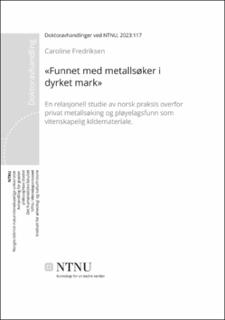| dc.contributor.advisor | Maixner, Birgit | |
| dc.contributor.advisor | Risbøl, Ole | |
| dc.contributor.advisor | Brattli, Terje | |
| dc.contributor.author | Fredriksen, Caroline | |
| dc.date.accessioned | 2023-04-20T14:50:50Z | |
| dc.date.available | 2023-04-20T14:50:50Z | |
| dc.date.issued | 2023 | |
| dc.identifier.isbn | 978-82-326-6565-5 | |
| dc.identifier.issn | 2703-8084 | |
| dc.identifier.uri | https://hdl.handle.net/11250/3064094 | |
| dc.description.abstract | English summary
This article-based PhD thesis in archaeology sets out to explore the phenomenon plough-zone finds from hobby metal detecting as kulturminner and potential source material within Norwegian cultural heritage management and archaeology. Various processes, discussions, and approaches within the Norwegian practice on metal detecting are described and discussed through the main objective - how does the Norwegian practice on hobby metal detecting affect plough-zone finds as scientific source material? Drawing on theoretical and methodical concepts from assemblage-thinking and actor-network theory, the study aims for a description of plough-zone finds’ emergence as a phenomenon in Norwegian archaeology, and their capacities for future archaeological knowledge.
The study is based on various types of data, including published literature, official documents, consultative statements, and data on metal detecting from two types of databases: Askeladden – the Norwegian database for kulturminner, and the five Norwegian databases for recorded archaeological objects – the gjenstandsbaser of Universitetsmuseenes gjenstandsdatabaser (MUSITark). Through four articles and additional analyses, this thesis articulates the specific processes related to the emergence of the particular phenomenon plough zone finds in the present.
My project identifies three discussions within Norwegian practice towards metal detecting. The first discussion focuses on the relationship between securing objects in the plough zone and securing automatically protected sites. Second, a new discussion emerges, considering the premises underlying the recognition of automatically protected sites. The third and last discussion concerns the conditions on which detectorists may continue to metal detect on automatically protected sites. My discussions are based on the premise that the specific conditions related to the management of hobby metal detecting in Norway, specifically the management of automatically protected sites, affect the emergence of particular objects as potential archaeological source material. Norwegian plough zone finds are arguably different from objects within similar find-circumstances in other countries.
In conclusion, the Norwegian practice on metal detecting, and some (although few) very prolific detectorists, affect plough zone finds in multiple ways. These include find numbers, composition and spatial distribution, the questions asked, and the data quality available for researchers. These components structure a rather specific set of capacities for potential future knowledge. | en_US |
| dc.description.abstract | Sammendrag
Dette artikkelbaserte prosjektet utforsker ulike prosesser, diskusjoner og tilnærminger knyttet til fenomenet pløyelagsfunn fra privat metallsøking i norsk kulturminneforvaltning. Hva gjør norsk praksis overfor privat metallsøking med pløyelagsfunn som vitenskapelig kildemateriale?
Arbeidet tar utgangspunkt i ulike typer data. Disse inkluderer publisert litteratur om metallsøking, saksdokumenter, høringsuttalelser, samt data fra to databaser: Riksantikvarens offisielle kulturminnedatabase Askeladden og Gjenstandsbasene i Universitetsmuseenes samlingsdatabaser (MUSITark). Med utgangspunkt i teoretiske og metodiske verktøy fra assemblage-tenking og aktør-nettverksteori beskrives tilkomsten av pløyelagsfunn som et fenomen i norsk arkeologi, og hvordan våre forvaltningspraksiser påvirker deres mulighetsrom for fremtidig kunnskap om fortiden.
Gjennom fire artikler og en sammenfattende analyse beskrives og diskuteres spesifikke prosesser knyttet til fenomenet pløyelagsfunn i nåtiden. Norsk praksis overfor privat metallsøking har tatt form i relasjon til tre diskusjoner. Disse diskusjonene handler om: 1) forholdet mellom sikring av gjenstander i pløyelaget og hensynet til automatisk fredete kulturminner, 2) hva som skal ligge til grunn for å erkjenne et automatisk fredet kulturminne i pløyelaget, og 3) å gi privatpersoner tillatelse til inngrep i automatisk fredete kulturminner. Mine diskusjoner legger til grunn at den norske forvaltningspraksisen, spesielt forvaltningen av automatisk fredete kulturminner, påvirker pløyelagsfunnenes tilblivelse som vitenskapelig kildemateriale. Norske pløyelagsfunn er ikke nødvendigvis sammenlignbare med funn fra lignende funnomstendigheter i andre land. Avhandlingen konkluderer med at norsk forvaltningspraksis og et mindre antall svært aktive detektorister påvirker pløyelagsfunn på mangfoldig vis. Dette inkluderer antall funn, geografisk spredning, lokalitetenes sammensetning, arkeologenes problemstillinger og datakvaliteten tilgjengelig for forskning. Disse faktorene påvirker pløyelagsfunnenes potensial som vitenskapelig kildemateriale. | en_US |
| dc.language.iso | nob | en_US |
| dc.publisher | NTNU | en_US |
| dc.relation.ispartofseries | Doktoravhandlinger ved NTNU;2023:117 | |
| dc.relation.haspart | Artikkel 1: Fredriksen, Caroline. Pløyelagsfunn i skjæringspunktet mellom forskningspotensial og forvaltningsprioriteringer: Fokus og holdninger i diskusjonen om privat metallsøking i Norge. Primitive tider 2019 ;Volum 21. s. 63-79. Open access article under the CC BY-NC 4.0 licence. Available at http://dx.doi.org/10.5617/pt.7536 | en_US |
| dc.relation.haspart | Artikkel 2: Fredriksen, Caroline. Pløyelagsfunn som automatisk fredete kulturminner: Kunnskapsdrevet forvaltning eller forvaltningsdrevet kunnskap?. Heimen - Lokal og regional historie 2021 ;Volum 58.(2) s. 136-151. Open access article under the CC BY-NC 4.0 licence. Available at http://dx.doi.org/10.18261/issn.1894-3195-2021-02-03 | en_US |
| dc.relation.haspart | Artikkel 3: Axelsen, Irmelin; Fredriksen, Caroline. Organically homegrown archaeological databases and their inherent ‘messiness’: The case of hobby metal detecting in Norway. This article is not yet published and is therefore not included. | en_US |
| dc.relation.haspart | Artikkel 4: Fredriksen, Caroline. A realm of virtual knowledge: Exploring the capacities of Norwegian Metal-detected assemblages. Norwegian Archaeological Review 2023 s. - Open access article under the CC BY 4.0 licence. Available at http://dx.doi.org/10.1080/00293652.2023.2181212 | en_US |
| dc.title | «Funnet med metallsøker i dyrket mark»: En relasjonell studie av norsk praksis overfor privat metallsøking og pløyelagsfunn som vitenskapelig kildemateriale | en_US |
| dc.type | Doctoral thesis | en_US |
| dc.subject.nsi | VDP::Humaniora: 000::Arkeologi: 090 | en_US |

